For those who enjoy celebrity restaurants like Jay Chou’s (周杰倫) fantastical Deja Vu, Chang Hui-mei’s (A-mei, 張惠妹) place may look a bit plain.
At the A8 Cafe & Gallery, the menu is rustic, with much of it hailing from her hometown Puyuma village of Tamalakaw in Taitung County.
Stylistically, the restaurant is a hipster’s dream. An eclectic design ethos expressed in black iron, exposed cement, red brick and solid wood create a chic vibe. Usually, a restaurant where great care is taken over style can appear neurotically absorbed in its own trendiness. But with A8, high-end elements are balanced by little knickknacks and vintage furniture, which are said to come from the owner’s personal collection. The skull rings on the table and the wall painting of horse anatomy may not be to everyone’s taste, but the space is welcoming, as if it belongs to a really cool person who invited you in to relax, have a good time with friends or be restfully alone.
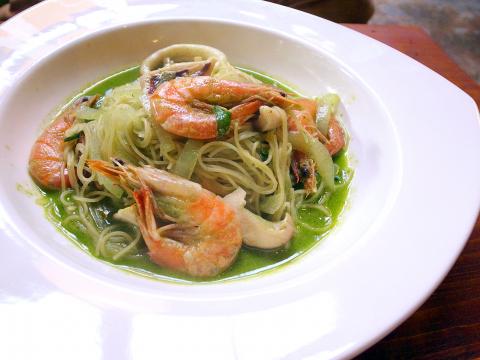
Photo: Ho Yi, Taipei Times
Children will definitely adore the menu’s golden fried dumplings (黃金煎餃, NT$200 for 10 and NT$250 for 15), which have a sweet corn and pork stuffing and are sprinkled with cheddar cheese and served on a crispy sheet made with more cheese. A local spin on French fries, the fried taro (炸芋條, NT$100) has an al-dente texture and uses the root vegetable grown in the Puyuma diva’s hometown.
The cafe offers a selection of pasta dishes, but the A8 spaghetti with garlic and chili (A8雀兒蒜味辣椒義大利麵, NT$250) my dining companions and I ordered last month was rather generic.
On the other hand, we loved our rainbow mix veggies (彩虹蔬菜, NT$250), which is a bowl of red and yellow bell peppers, zucchini and king oyster mushrooms brought to life by excitingly tangy mustard seeds.
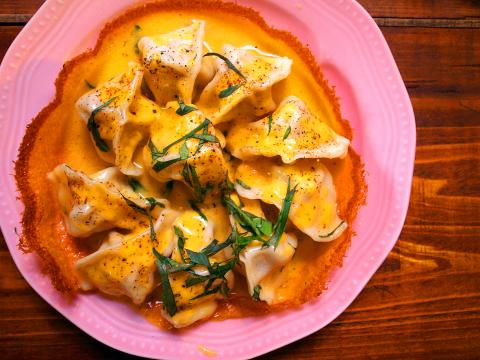
Photo: Ho Yi, Taipei Times
My favorite part of the menu, however, was the home-style Tamalakaw dishes. Light-flavored and cooked with simple ingredients, the Puyuma loofah noodle soup (普悠瑪瓜瓜麵, NT$200) immediately brings a soothing sensation not unlike the warm, nourishing food your mother made for you when you were sick and needed to be pampered as a child.
The wait staff, many of whom hail from the Puyuma tribe, seem amicable and at ease and help to create a homey feel to the dining establishment. Below the restaurant, an art gallery holds exhibitions from time to time. Currently on display are oil paintings created by artists with disabilities
A8 also boasts a popular selection of desserts, including red-wine rose ice cream (紅酒玫瑰冰淇淋, NT$180) and waffles with apple, orange or mulberry jelly (A8自製果醬鬆餅, NT$220) that’s made in-house.
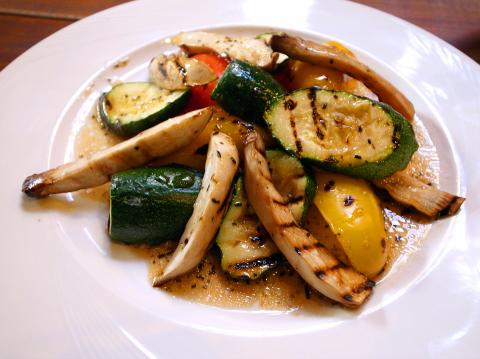
Photo: Ho Yi, Taipei Times
There are few choices of beer (NT$180 and NT$200) from the Netherlands and Germany, as well as a small collection of cocktails (NT$200 and NT$250) and wine (NT$1,250 and NT$1,500 per bottle, NT$250 and NT$280 per glass). A8’s signature drink is coffee made from beans grown and harvested in Tamalakaw. Its name, Haliwanes (哈莉瓦嫩思, NT$220), means rainbow in the Puyuma language.
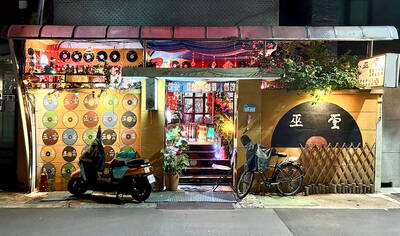
The Lee (李) family migrated to Taiwan in trickles many decades ago. Born in Myanmar, they are ethnically Chinese and their first language is Yunnanese, from China’s Yunnan Province. Today, they run a cozy little restaurant in Taipei’s student stomping ground, near National Taiwan University (NTU), serving up a daily pre-selected menu that pays homage to their blended Yunnan-Burmese heritage, where lemongrass and curry leaves sit beside century egg and pickled woodear mushrooms. Wu Yun (巫雲) is more akin to a family home that has set up tables and chairs and welcomed strangers to cozy up and share a meal
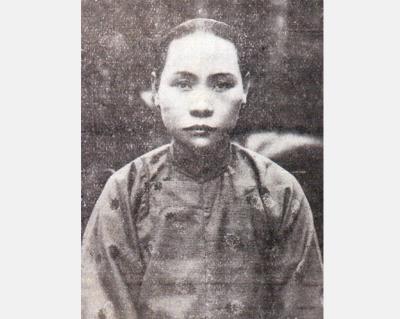
Dec. 8 to Dec. 14 Chang-Lee Te-ho (張李德和) had her father’s words etched into stone as her personal motto: “Even as a woman, you should master at least one art.” She went on to excel in seven — classical poetry, lyrical poetry, calligraphy, painting, music, chess and embroidery — and was also a respected educator, charity organizer and provincial assemblywoman. Among her many monikers was “Poetry Mother” (詩媽). While her father Lee Chao-yuan’s (李昭元) phrasing reflected the social norms of the 1890s, it was relatively progressive for the time. He personally taught Chang-Lee the Chinese classics until she entered public

Last week writer Wei Lingling (魏玲靈) unloaded a remarkably conventional pro-China column in the Wall Street Journal (“From Bush’s Rebuke to Trump’s Whisper: Navigating a Geopolitical Flashpoint,” Dec 2, 2025). Wei alleged that in a phone call, US President Donald Trump advised Japanese Prime Minister Sanae Takaichi not to provoke the People’s Republic of China (PRC) over Taiwan. Wei’s claim was categorically denied by Japanese government sources. Trump’s call to Takaichi, Wei said, was just like the moment in 2003 when former US president George Bush stood next to former Chinese premier Wen Jia-bao (溫家寶) and criticized former president Chen

President William Lai (賴清德) has proposed a NT$1.25 trillion (US$40 billion) special eight-year budget that intends to bolster Taiwan’s national defense, with a “T-Dome” plan to create “an unassailable Taiwan, safeguarded by innovation and technology” as its centerpiece. This is an interesting test for the Chinese Nationalist Party (KMT), and how they handle it will likely provide some answers as to where the party currently stands. Naturally, the Lai administration and his Democratic Progressive Party (DPP) are for it, as are the Americans. The Chinese Communist Party (CCP) is not. The interests and agendas of those three are clear, but